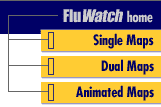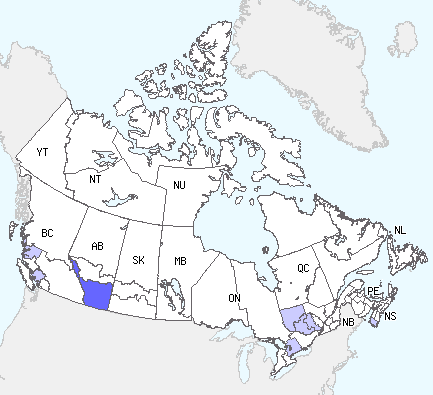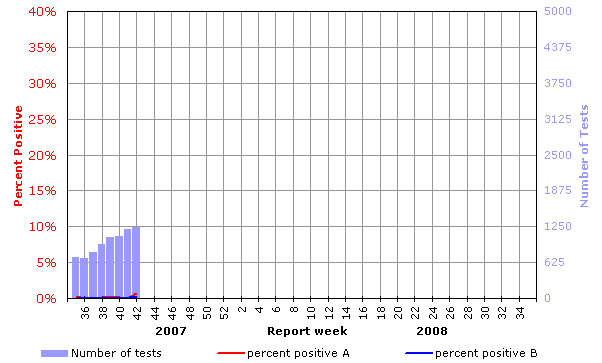Common menu bar links
E-mail this page
Fluwatch
Increasing influenza activity in southern Alberta;
activity remains low in the rest of the country
During week 42, influenza activity increased in the southern region
of Alberta where localized activity was reported while influenza
activity remained low in the rest of the country. The number of
regions reporting sporadic influenza activity increased from 4 to 7
regions this week compared to the previous week (3 in Quebec, 2 in
Ontario, 1 in Nova Scotia and 1 in British Columbia) (see map). In week 42, 10 of the 1,238 (0.8%) specimens
tested was positive for influenza virus, only 1 of which was
influenza B (from Nova Scotia). Of the influenza detections to
date, 88% (15/17) were influenza A and 12% (2/17) were influenza B
(see table). The ILI consultation rate remained
similar to previous weeks (12 ILI consultations per 1,000 patient
visits) and is within the expected range (see
ILI graph). Sentinel response rates over recent weeks have been
low but are expected to increase as the season progresses. In week
42, 1 new outbreak in a LTCF was reported in southern Alberta.
Since the start of the season, 2 LTCF outbreaks have been reported
(in Ontario and Alberta). In the current season to date, no new
laboratory-confirmed influenza-associated paediatric
hospitalizations were reported through the Immunization Monitoring
Program Active (IMPACT) network.
Antigenic Characterization:
The National Microbiology Laboratory (NML) has characterized 4
influenza viruses for the 2007-2008 influenza season, 2
A/Wisconsin/67/2005(H3N2)-like viruses (from Ontario and British
Columbia) and 2 B/Florida/07/2004-like viruses belonging to the
B/Yamagata/16/1988 lineage (from Nova Scotia and Ontario) (see pie chart).
* The WHO recommends that the vaccines to be used in the 2007-2008 season (northern hemisphere) contain the following: an A/Solomon Islands/3/2006 (H1N1)-like virus; an A/Wisconsin/67/2005 (H3N2)-like virus; and a B/Malaysia/2506/2004-like (B/Victoria/2/1987 lineage) virus.
Antiviral Resistance:
Since the start of the season, the NML has tested 4 influenza A
isolates (all H3N2) for amantadine resistance (from Ontario and
British Columbia). Three (75% or 3/4) of the isolates tested were
resistant to amantadine (all 3 resistant isolates originated from
Ontario) (see recommendation from the
2006-2007 influenza season below).
CDC: During week 41, a low level of influenza activity was reported in the United States. Of the 1,136 specimens tested for influenza virus, 21 (1.9%) were positive. The proportion of deaths attributed to pneumonia and influenza was slightly above the epidemic threshold, however the proportion of outpatient visits for ILI (1.3%) was below national and region-specific baseline levels. From May 20 - September 29, 2007, CDC antigenically characterized 14 influenza isolates: 2 influenza A (H1) (both A/Solomon Islands/3/2006(H1N1)-like); 10 influenza A (H3) (6 A/Wisconsin/67/2005(H3N2)-like, 2 A/Brisbane/10/2007(H3N2)-like and 2 showed reduced titers to A/Wisconsin/67/2005 and A/Brisbane/10/2007); and 2 B/Yamagata lineage viruses. A/Brisbane/10/2007 is a recent antigenic variant related to the A/Wisconsin/67/2005 vaccine virus.
EISS: In week 42, low levels of influenza activity in Europe were reported with 26 countries reporting no or only sporadic influenza activity. There have been sporadic laboratory confirmed cases of influenza in the past 4 weeks: 18 cases of influenza A and 9 cases of influenza B. In the last 4 weeks, the consultation rates for ILI and/or ARI have been at levels usually seen outside the winter period. Based on antigenic and/or genetic characterization of 3 influenza viruses, 2 were A/Solomon Islands/3/2006(H1N1)-like and 1 was B/Florida/4/2006-like (B/Yamagata/16/88 lineage). However, it is too early to say which virus type or subtype will become dominant in Europe this season.
Human Avian Influenza: Since 20 October 2007, The WHO reported one new case of human infection with the H5N1 avian influenza virus from Indonesia. The case was a 5-year-old female developed symptoms on 14 October, was hospitalized on 20 October and died in an AI referral hospital on 22 October.
Recommendation
for the Use of Amantadine for Treatment and Prevention of
Influenza
The Public Health Agency of Canada does not recommend the use of
amantadine for treatment or prevention of influenza for the
2006-2007 season. This recommendation will be revisited if new
information becomes available.
Total number of influenza tests performed and number of positive tests by province/territory of testing laboratory, Canada, 2007-2008
| Province of reporting laboratories |
Report
Period: October 14, 2007 to October 20, 2007 |
Season to
Date: August 26, 2007 to October 20, 2007 |
||||||
| Total # Influenza Tests |
# of Positive Tests | Total # Influenza Tests |
# of Positive Tests | |||||
| Influenza A | Influenza B | Total | Influenza A | Influenza B | Total | |||
| NL | 6 | 0 | 0 | 0 | 21 | 0 | 0 | 0 |
| PE | 0 | 0 | 0 | 0 | 16 | 0 | 0 | 0 |
| NS | 9 | 0 | 1 | 1 | 76 | 0 | 1 | 1 |
| NB | 15 | 0 | 0 | 0 | 53 | 0 | 0 | 0 |
| QC | 166 | 1 | 0 | 1 | 1279 | 1 | 0 | 1 |
| ON | 328 | 1 | 0 | 1 | 1980 | 5 | 1 | 6 |
| MB | 39 | 0 | 0 | 0 | 279 | 0 | 0 | 0 |
| SK | 87 | 0 | 0 | 0 | 564 | 0 | 0 | 0 |
| AB | 555 | 7 | 0 | 7 | 3298 | 8 | 0 | 8 |
| BC | 33 | 0 | 0 | 0 | 195 | 1 | 0 | 1 |
| Canada | 1238 | 9 | 1 | 10 | 7761 | 15 | 2 | 17 |
Specimens from NT, YT, and NU are sent to reference laboratories in other provinces.
Note: Cumulative data includes updates to previous weeks; due to reporting delays, the sum of weekly report totals do not add up to cumulative totals.
Abbreviations: Newfoundland/Labrador (NL), Prince Edward Island (PE), New Brunswick (NB), Nova Scotia (NS), Quebec (QC), Ontario (ON), Manitoba (MB), Saskatchewan (SK), Alberta (AB), British Columbia (BC), Yukon (YT), Northwest Territories (NT), Nunavut (NU)
Respiratory virus laboratory detections in Canada, by
geographic regions, are available weekly on the following
website:
<http://www.phac-aspc.gc.ca/bid-bmi/dsd-dsm/rvdi-divr/index-eng.php>
Number of influenza surveillance regions† reporting widespread or localized influenza activity, Canada, by report week, 2007-2008 (N=66)


† sub-regions within the province or territory as defined by the provincial/territorial epidemiologist. Graph may change as late returns come in.
Influenza Activity
Level by Provincial and Territorial |
|||||||||||||
|
|||||||||||||
Note: Influenza activity levels, as represented
on this map, are assigned and reported by Provincial and
Territorial Ministries of Health, based on laboratory
confirmations, sentinel ILI rates (see graphs and tables) and
outbreaks. Please refer to detailed definitions. For areas where no data is
reported, late reports from these provinces and territories will
appear on the FluWatch website. Select single maps by
report week to get this updated information. Click on the map to view provinces/territories and maps for other weeks. |
|||||||||||||
Influenza tests reported and percentage of tests positive, Canada, by report week, 2007-2008
Percent positive influenza tests, compared to other respiratory viruses, Canada, by reporting week, 2007-2008
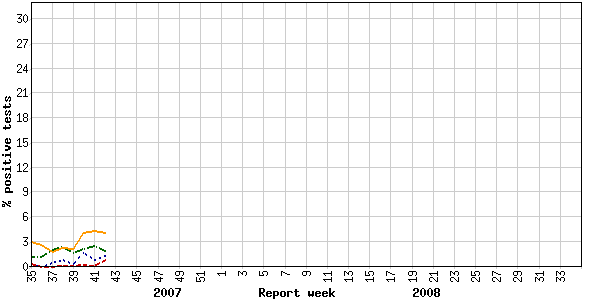

Influenza strain
characterization, Canada, cumulative, 2007-2008 influenza season by
the Respiratory Viruses Section at the National Microbiology
Laboratory
[N=4]

{Strain characterization, number identified, per cent of total number}
NACI recommends that the trivalent vaccine for the 2007-2008 season in Canada contain A/Solomon Islands/3/2006 (H1N1)-like virus; an A/Wisconsin/67/2005 (H3N2)-like virus; and a B/Malaysia/2506/2004-like virus.
Influenza-like illness (ILI) consultation rates, Canada, by report week, 2007-2008 compared to 1996/97 through to 2006/07 seasons
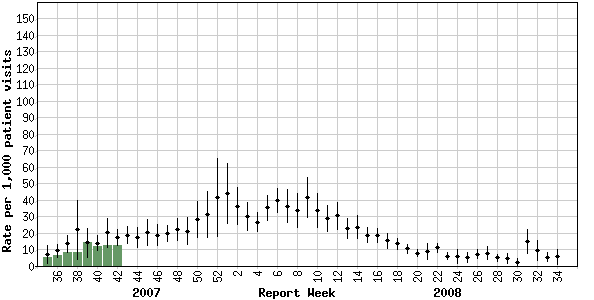

Note: No data available for mean rate in previous years for weeks 19 to 39 (1996-1997 through 2002-2003 seasons).
Number of New Outbreaks in Long Term Care Facilities, Canada, by Report Week, 2007-2008


Please note that the above graphs may change as late returns come in.


